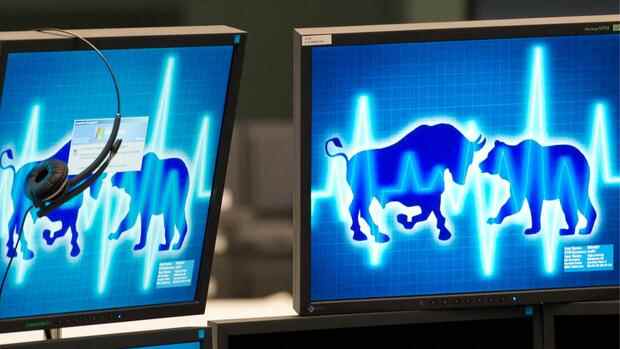Symbol for rising and falling prices on the stock market. A directional decision has not yet been made.
(Photo: dpa)
The Wall Street tremor was violent: US stock markets experienced their weakest trading day since June 2020 after inflation in the United States fell a fraction less than expected. It could have been a harbinger of what’s to come for the markets, both positive and negative.
First of all, the losses look heavy, but in the end the markets only gave back the gains of the recent rally. Not even that on the German stock market. The US leading index S&P 500 is still seven percent above its low for the year, the German leading index Dax initially defended the recently conquered mark of 13,000 points.
Nevertheless, these price losses are evidence of the pronounced uncertainty that prevails on the market. There is currently no clear market opinion: the assessments of how far the central banks will raise their interest rates and whether there will be a severe, mild or no recession diverge widely, which is reflected in the repeatedly first rising and then falling prices.
On the one hand, there is currently a lot of money on the sidelines. The cash quotas of many professional investors are historically high – this is not a permanent state. And so, investors jumped at every hint of a recovery to jump in for fear of missing out. Because with such a pent-up potential demand, a recovery should be dynamic. This was also the case after other bear markets – i.e. longer phases of falling prices.
Top jobs of the day
Find the best jobs now and
be notified by email.
The stage is set for further price fluctuations
On the other hand, the markets are currently reacting sensitively to inflation data and statements by the central banks. Because unlike in the past, the interest rate path of the central banks – i.e. up to which point they will raise interest rates – is not clear. After the weak US inflation data, for example, market participants adjusted their interest rate expectations upwards and reacted radically: shares, especially the recently recovered tech stocks, flew out of their portfolios.
This back and forth on the markets is likely to continue until one of the numerous global negative factors such as the Ukraine war, fears of inflation and fears of recession resolve. What is decisive here is not a positive ending, but clarity. In a negative case, this could lead to a final sell-off, which would at the same time be the breeding ground for a recovery. On a positive note, the recent recovery rallies have only provided a foretaste of the market reaction to come.
As long as there is no such clarity, however, everything is ready for further price fluctuations on the stock exchanges – for example following the interest rate decision by the US Federal Reserve next Wednesday.
More: These ten indicators show when it can be worth entering the stock market
